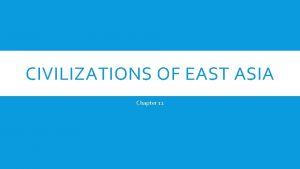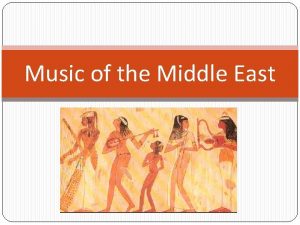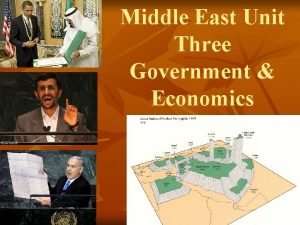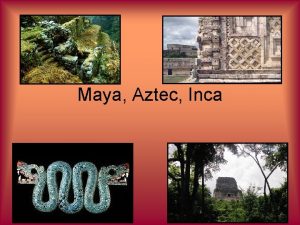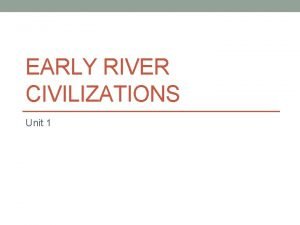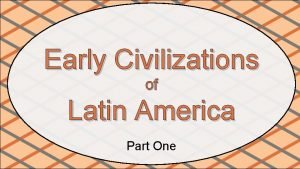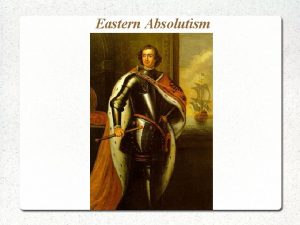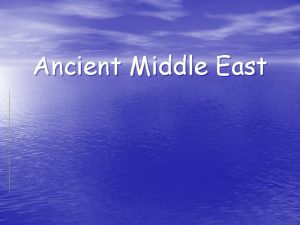SOL Quiz 4 Middle Eastern Civilizations 1 All












- Slides: 12

SOL Quiz 4 Middle Eastern Civilizations

1. All of the following are necessary for a Neolithic culture to evolve into a civilization, EXCEPT a. the development of a system of public education for the community b. job specialization with different groups performing different tasks c. the growth of a settlement large enough to be a city d. a centralized government for the city The first civilizations did not need a system of public education because children could be taught necessary work, social, and survival skills within the family. Sometimes arrangements were made with artisans to teach specialized skills to children as apprentices. First civilization had to have cities ruled by a central government, and people had to acquire specialized jobs as priests, builders, potters, carpenters, etc. Such work specialization, however, could only develop when farmers produced a food surplus to feed these artisans and religious and government officials.

2. The city-states of Sumer, the world's earliest civilization, developed in a. Mesopotamia b. Egypt c. the Levant d. Anatolia The early civilization of the city-states of Sumer developed in Mesopotamia on the plains between the southern parts of the Tigris and Euphrates rivers and on the delta formed where the rivers joined before entering the Persian Gulf. The first civilizations began between 4000 B. C. and 3500 B. C.

3. The source of the Tigris and Euphrates rivers is in a. the mountains of Iran (then Persia) b. Mesopotamia c. the mountains of Turkey (then Anatolia) d. the Persian Gulf All major rivers have their source in the mountains. Both the Tigris and Euphrates rivers begin in the mountains of Turkey to the north and flow south to empty into the Persian Gulf. Mesopotamia means "land between the rivers. "

4. The Fertile Crescent was a major means of migration in ancient times because a. rivers flow through all of the land in the arc of the Fertile Crescent b. it is the shortest distance between Mesopotamia and the Mediterranean Sea c. the land of the Fertile Crescent can support agriculture and grazing d. other routes from Mesopotamia to the Mediterranean are blocked by water The Fertile Crescent was an important avenue of migration because the land is relatively flat and can support agriculture and grazing. Migrations took many years, so people grazed their herds along the way and sometimes planted crops and stayed in place for a number of years. The Fertile Crescent is believed to be the route followed by the ancient Hebrews from Ur in Mesopotamia to the Mediterranean coast.

5. Scribes became important in Sumerian and Egyptian life because they a. were the only people who could read and write b. judged property disputes after the annual floods receded c. taught the priests and nobles to read and write d. were the poets, authors, and scholars of the time Scribes were important because they were the only people in the culture who could read and write the difficult cuneiform or hieroglyphics forms of written language. To be a scribe was a highly specialized skill learned only after years of apprenticeship and study. The scribes kept records of commercial transactions and court judgments, wrote and read communications, and kept the official government archives. Their work was essential to the orderly functioning of the society, but it was not creative, unless they chose to write literature in their spare time.

6. The people in the highest social class in the city-states of Sumer were a. artisans b. scribes c. farmers d. Priests The priests of the temple were the highest social class in Sumer. They led the prayers and called for the sacrifices to the gods to ask their favors for a good harvest. The priests were the most important leaders in the city-states until the warrior chiefs came to power as kings. Scribes and artisans were members of the small middle class whereas farmers, the vast majority of the people, were the lowest social class, but above slaves in social standing.

7. The Egyptians built pyramids as a. temples b. tombs c. monuments to victories d. lookout towers The pyramids of Egypt were built as tombs for kings of the Old Kingdom. They were built entirely of blocks of stone, except for passages that led to inner chambers where the body of the pharaoh and many possessions were placed. After entombment, the passages were filled in. However, all pyramids were later invaded by robbers seeking the wealth of the pharaohs.

8. Cuneiform writing originated with the Sumerians about 5, 300 years ago. The adoption of cuneiform writing by the Babylonians, Assyrians, and Hittites is an example of a. nationalism b. economic determinism c. cultural diffusion d. ethnic identity Cultural diffusion is the spread of cultural factors, teachings, and skills originating in one society to another. The Babylonians, Assyrians, and Hittites were later civilizations that developed north of the Sumerians and conquered Mesopotamia. The Babylonians who conquered the Sumerians learned their system of writing, which was passed on through later conquests and other cultural contacts. Cuneiform writing was used in the Middle East for thousands of years before it was replaced by simpler forms of writing.

9. In ancient times, coins made from gold and silver gradually replaced which commonly used means of exchange in commerce? a. beads and shells b. cuneiform tablets c. slaves d. Barter was the most common means of exchange before coins were used beginning sometime before 700 B. C. Coins were first used in Lydia, a kingdom in northwest Anatolia. The use of coins spread rapidly among merchants after the Persians encouraged the development of a money economy. However, barter continued as the medium of exchange among peasants and in the local village economy.

10. Which culture is MOST closely associated with seafaring, trading, and establishing colonies on other continents that border the Mediterranean Sea? a. Phoenicians b. Assyrians c. Hittites d. Egyptians The Phoenicians who lived along the Levant became a major seafaring and trading nation. They sent ships and colonists to Spain and Sicily in Europe and to North Africa where they established the cities of Carthage and Utica. The Assyrians and Hittites were militant nations that invaded other regions with land armies. The Egyptians sent out merchant ships that influenced island cultures in the eastern Mediterranean, but did not establish colonies.

11. Christianity FIRST began as an outgrowth of which religion? a. Zoroastrianism b. the religion of the Phoenicians c. Judaism d. the religion of the Egyptians
 Chapter 11 civilizations of east asia
Chapter 11 civilizations of east asia Contoh sol koloid
Contoh sol koloid Aerophone
Aerophone Metu ocw
Metu ocw Middle eastern map
Middle eastern map Fertile crescent ap human geography definition
Fertile crescent ap human geography definition Definition of eastern europe
Definition of eastern europe Name all rays
Name all rays Mayans incas aztecs
Mayans incas aztecs Map of river valley civilizations
Map of river valley civilizations 4 river valley civilizations
4 river valley civilizations Early south american civilizations
Early south american civilizations Chapter 9 lesson 1 ancient india
Chapter 9 lesson 1 ancient india
